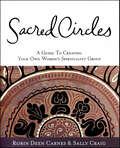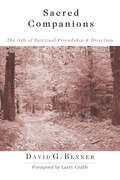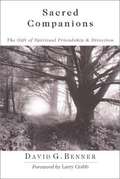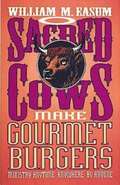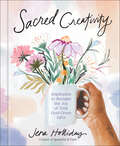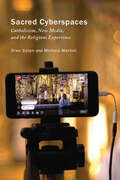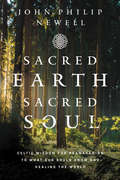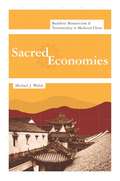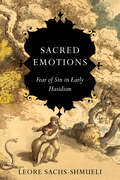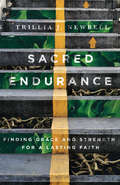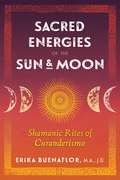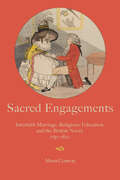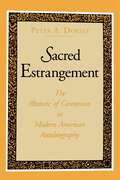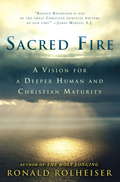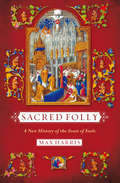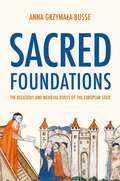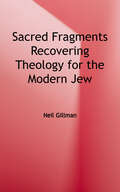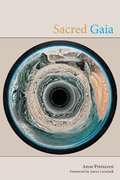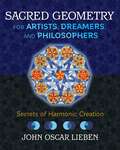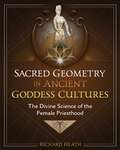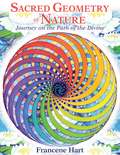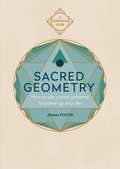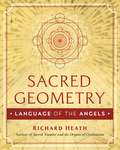- Table View
- List View
Sacred Circles: A Guide To Creating Your Own Women's Spirituality Group
by Robin Deen Carnes Sally CraigFrom Jewish to Christian, Mormon and Pagan, women's sacred circles are sprouting up everywhere, in astonishing variety providing a haven where essential female values can be discussed and embraced.This much-needed guide celebrates the rich diversity of women's spiritual lives and offers practical, step-by-step advice for those who want to create and sustain a spirituality group of their own.Sacred Circle shows us how we can use a group to explore our relationship to the sacred, and honor the divine in everyday life. The authors, drawing from their own group experiences as well as those of many diverse groups around the country, share the model they've developed, while offering wise advise on how and why groups work. They propose circle basics, such as listening without an agenda and rotating leadership, and also offer reflections on the power of personal storytelling and thoughts on reclaiming and reinventing ritual. Women longing for a powerful and supportive feminine community in which to thrive spiritually will find vital wisdom here.
Sacred Companions: The Gift of Spiritual Friendship Direction
by David G. BennerECPA 2003 Gold Medallion Finalist
Sacred Companions: The Gift of Spiritual Friendship and Direction
by David G. BennerDavid G. Benner introduces you to the riches of spiritual friendship and direction, explaining what they are, how they are practiced and how they move beyond mere moral lifestyle accountability to care for souls.
Sacred Cows Make Gourmet Burgers: Ministry Anytime, Anywhere, By Anyone
by Bill EasumThis book shows how an atmosphere of permission-giving, which signals the end of leaders as enablers, can help church leaders transcend bureaucracy and enhance spiritual gifts rather than assign them. The 'sacred cows' of control and regulation can be devoured, as leaders and people are converted to a new style of ministry.
Sacred Creativity: Inspiration to Reclaim the Joy of Your God-Given Gifts
by Jena HollidayIn this gorgeous and inspiring book, the beloved artist behind Spoonful of Faith shows you how to overcome your fears and harness your own creative gifts as an act of worship.With thoughtful stories, powerful reflections, hand lettering, and beautiful original artwork, Jena Holliday invites you to discover how you uniquely reflect the heart of a creative God. Using the lessons she&’s learned along the way and creative prompts throughout, Jena encourages readers to overcome the pressure to perform, face the fears of failure and imposter syndrome, believe in the gifts that God has given, step forward in creativity, and delight in the fruit that comes from freely creating as an act of worship.Each section provides space to digest what you&’ve read with thoughtful questions to respond to in words or drawings, an affirmation to encourage you, and a prayer to guide you. With suggested songs to listen to as well, Sacred Creativity is the ultimate invitation to offer your God-given gifts back to the Creator in joyful worship. To yield to the One who Created all, and allow your art, creativity, and life to be a love offering.
Sacred Cyberspaces: Catholicism, New Media, and the Religious Experience (Advancing Studies in Religion)
by Oren Golan Michele MartiniIn recent years every major institution has had to adapt to the fast-evolving technologies of the digital age or risk being left behind. Amid a global crisis of faith and declining levels of religious participation in places around the world, the Catholic Church has likewise come face to face with the challenges and possibilities of new media. Sacred Cyberspaces reveals how long-standing conflicts over power, influence, and legitimacy within religious organizations are being waged in the digital realm. Oren Golan and Michele Martini describe the tensions that arise as religious groups seek to reach the faithful in online spaces where traditional clerical authorities have less expertise and control. Focusing on the Catholic world, they examine the rise of devotional digital entrepreneurship and the roles of lay religious webmasters: the video makers, app developers, and web designers who devote their lives to evangelization and who literally run the show. The book also explores the nature of religious experience as it pivots to online platforms: cyberculture, prayer, ceremonies, pilgrimage, proselytization, and the relation to the transcendental.From live-streaming at world-famous sites in the Holy Land to the Instagram feed of Pope Francis, Sacred Cyberspaces evaluates the contemporary media strategies of the Catholic Church and sheds light on the future of religion online.
Sacred Earth, Sacred Soul: Celtic Wisdom for Reawakening to What Our Souls Know and Healing the World
by John Philip NewellA leading spiritual teacher reveals how Celtic spirituality—listening to the sacred around us and inside of us—can help us heal the earth, overcome our conflicts, and reconnect with ourselves.John Philip Newell shares the long, hidden tradition of Celtic Christianity, explaining how this earth-based spirituality can help us rediscover the natural rhythms of life and deepen our spiritual connection with God, with each other, and with the earth. Newell introduces some of Celtic Christianity’s leading practitioners, both saints and pioneers of faith, whose timeless wisdom is more necessary than ever, including: Pelagius, who shows us how to look beyond sin to affirm our sacredness as part of all God’s creation, and courageously stand up for our principles in the face of oppression.Brigid of Kildare, who illuminates the interrelationship of all things and reminds us of the power of the sacred feminine to overcome those seeking to control us.John Muir, who encourages us to see the holiness and beauty of wilderness and what we must do to protect these gifts.Teilhard de Chardin, who inspires us to see how science, faith, and our future tell one universal story that begins with sacredness.By embracing the wisdom of Celtic Christianity, we can learn how to listen to the sacred and see the divine in all of creation and within each of us. Human beings are inherently spiritual creatures who intuitively see the sacred in nature and within one another, but our cultures—and at times even our faiths—have made us forget what each of us already know deep in our souls but have learned to suppress. Sacred Earth, Sacred Soul offers a new spiritual foundation for our lives, once centered on encouragement, guidance, and hope for creating a better world.
Sacred Economies: Buddhist Monasticism and Territoriality in Medieval China (The Sheng Yen Series in Chinese Buddhist Studies)
by Michael WalshBuddhist monasteries in medieval China employed a variety of practices to ensure their ascendancy and survival. Most successful was the exchange of material goods for salvation, as in the donation of land, which allowed monks to spread their teachings throughout China. By investigating a variety of socioeconomic spaces produced and perpetuated by Chinese monasteries, Michael J. Walsh reveals the "sacred economies" that shaped early Buddhism and its relationship with consumption and salvation.Centering his study on Tiantong, a Buddhist monastery that has thrived for close to seventeen centuries in southeast China, Walsh follows three main topics: the spaces monks produced, within and around which a community could pursue a meaningful existence; the social and economic avenues through which monasteries provided diverse sacred resources and secured the primacy of Buddhist teachings within an agrarian culture; and the nature of "transactive" participation within monastic spaces, which later became a fundamental component of a broader Chinese religiosity. Unpacking these sacred economies and repositioning them within the history of religion in China, Walsh encourages a different approach to the study of Chinese religion, emphasizing the critical link between religious exchange and the production of material culture.
Sacred Emotions: Fear of Sin in Early Hasidism (Stanford Studies in Jewish Mysticism)
by Leore Sachs-ShmueliScholars have long argued that early Hasidic teachings introduced a psychological dimension to kabbalistic traditions and revitalized modern Judaism. Focused on the inner soul, Hasidism encouraged worshippers to experience joy and delight through their enthusiastic practices. In this new work grounded in the historical study of emotions, Leore Sachs-Shmueli shows that Hasidic teachers and preachers also nurtured and even promoted the negative emotions of yirah, an emotional cluster that encompasses fear, apprehension, anxiety, and awe. Exploring their roots in classical texts of Kabbalah, including the Zohar and works of Safed Kabbalah, Sachs-Shmueli demonstrates how early Hasidic masters like the Baal Shem Tov, the circle of the Maggid of Mezhrich, Shneur Zalman of Liadi, and R. Nachman of Bratslav deliberately cultivated a tense emotional culture through the mental guidelines in their texts. Through an emphasis on God-fearing and the fear of sin, they motivated followers of the new movement to attain the mystical ideal while simultaneously fostering a social community devoted to divine worship according to Jewish law, in the face of persecution and secularization. For readers interested in Jewish mysticism and Hasidism, Sacred Emotions argues that negative emotions serve as crucial catalysts for intensifying religious devotion and shaped the rise and cohesion of the Hasidic movement.
Sacred Endurance: Finding Grace and Strength for a Lasting Faith
by Trillia NewbellGod promises to finish the good work he began in us—but that doesn't come without bumps in the road.
Sacred Energies of the Sun and Moon: Shamanic Rites of Curanderismo
by Erika BuenaflorA practical guide to ancient Mesoamerican solar and lunar rites for healing and transformation • Details shamanic rituals and practices for each period of the day, including dawn, sunrise, noon, sunset, and midnight, to best harness the energies of the sun, night sun, and moon for specific purposes, such as divination, journeying with animal spirit guides, or spiritual wisdom • Incorporates shamanic breathwork, dreamwork, mantra chanting, mudras, dancing and movement, toning, chakra work, crystals, herbs, and limpias (shamanic cleanses) • Explores how nighttime energies are affected by the phases of the moon, offering specific practices for each phase Ancient Mesoamerican shamans and modern practitioners of curanderismo--a Latin American shamanic healing practice--divide each day and night into distinct periods based on the sacred rhythms of the sun and moon, with each time offering opportunities to connect with specific celestial energies for healing and transformation. In this hands-on guide to working with the sacred energies of the sun, night sun, and moon, curandera Erika Buenaflor details the rites, rituals, and deities for each part of the day and night and explores the sacred tools and techniques used by ancient Mesoamerican shamans for harnessing solar and lunar energies. She explains how the sun is the source of soul energy that heals, animates, strengthens, and revitalizes us on many levels, while night energies are transformative and conducive for connecting with nonordinary realms. She explores rituals for dawn, sunrise, and midmorning to harness the energies of creation and new beginnings; for noon and afternoon to promote peak strength and spiritual wisdom; for sunset and dusk to bring about transformation, perform divination, and journey with animal spirit guides; and for midnight and predawn to facilitate shamanic dreamwork, connect with the ancestors, make offerings, and regenerate at the deepest levels. She also explores how nighttime energies are affected by the phases of the moon and offers specific practices for each phase. By intentionally tuning our activities to the rhythms of the sun and moon, we can invite in their sacred energies of abundance and healing for more healthy, creative, mindful, and happy lives.
Sacred Engagements: Interfaith Marriage, Religious Toleration, and the British Novel, 1750–1820
by Alison ConwayA revelatory reading of the British novel that considers interfaith marriage, religious toleration, and the ethics of sociability.Bringing together feminist theory, novel criticism, and religious studies, Alison Conway's Sacred Engagements advances a postsecular reading of the novel that links religious tolerance and the eighteenth-century marriage plot. Conway explores the historical roots of the vexed questions that interfaith marriage continues to raise today. She argues that narrative wields the power to imagine conjugal and religious relations that support the embodied politics crucial to a communal, rather than state-sponsored, ethics of toleration.Conway studies the communal and gendered aspects of religious experience embedded in Samuel Richardson's account of interfaith marriage and liberalism's understandings of toleration in Sir Charles Grandison. In her readings of Frances Brooke, Elizabeth Inchbald, and Maria Edgeworth, Conway considers how women authors reframe the questions posed by Grandison, representing intimacy, authorship, and women's religious subjectivity in ways that challenge the social and political norms of Protestant British culture. She concludes with reflections on Jane Austen's Mansfield Park and the costs of a marriage plot that insists on religious conformity. By examining the complex epistemologies of the interfaith marriage plot, Sacred Engagements counters the secularization thesis that has long dominated eighteenth-century novel studies. In so doing, the book recognizes those subjects otherwise ignored by liberal political theory and extrapolates how a genuinely inclusive tolerance might be imagined in our own deeply divided times.
Sacred Estrangement: The Rhetoric of Conversion in Modern American Autobiography
by Peter A. DorseySacred Estrangement analyzes certain works by important American writers and thinkers in the context of the "rhetoric of conversion." Such analysis is especially valuable because it provides a reliable index of the relationship between the self and larger communities. Traditionally, "conversion" has served a socializing function, signifying that one has come into alignment with certain linguistic, behavioral, and cultural expectations. The socialization process is particularly apparent in the Christian conversion narratives of the seventeenth through nineteenth centuries: by publicly testifying to a conversion experience, believers became empowered members, not only of God's elect community but also of a local population. As modern autobiography developed in the eighteenth and nineteenth centuries, the Christian pattern was secularized and individualized. Conversion became a model for many kinds of psychological change. With the coming of the twentieth century, however, the authors upon whom Peter Dorsey focuses, including William and Henry James, Henry Adams, Edith Wharton, Ellen Glasgow, Zora Neale Hurston, and Richard Wright, radically revised conversion rhetoric. If conversion had traditionally linked the search for illumination with the search for a defined social role, these writers increasingly used conversion as an index of estrangement from mainstream America. Dorsey documents this profound change in the way American intellectuals defined the "self," not in terms of personal orientation toward or away from a given community, but as a resistance to such an orientation altogether, as if social forces by their "nature" were a threat to personal identity.
Sacred Estrangement: The Rhetoric of Conversion in Modern American Autobiography (G - Reference, Information and Interdisciplinary Subjects)
by Peter A. DorseySacred Estrangement analyzes certain works by important American writers and thinkers in the context of the "rhetoric of conversion." Such analysis is especially valuable because it provides a reliable index of the relationship between the self and larger communities. Traditionally, "conversion" has served a socializing function, signifying that one has come into alignment with certain linguistic, behavioral, and cultural expectations. The socialization process is particularly apparent in the Christian conversion narratives of the seventeenth through nineteenth centuries: by publicly testifying to a conversion experience, believers became empowered members, not only of God's elect community but also of a local population. As modern autobiography developed in the eighteenth and nineteenth centuries, the Christian pattern was secularized and individualized. Conversion became a model for many kinds of psychological change. With the coming of the twentieth century, however, the authors upon whom Peter Dorsey focuses, including William and Henry James, Henry Adams, Edith Wharton, Ellen Glasgow, Zora Neale Hurston, and Richard Wright, radically revised conversion rhetoric. If conversion had traditionally linked the search for illumination with the search for a defined social role, these writers increasingly used conversion as an index of estrangement from mainstream America. Dorsey documents this profound change in the way American intellectuals defined the "self," not in terms of personal orientation toward or away from a given community, but as a resistance to such an orientation altogether, as if social forces by their "nature" were a threat to personal identity.
Sacred Fire: A Vision for a Deeper Human and Christian Maturity
by Ronald RolheiserWhen one reaches the highest degree of human maturity, one has only one question left: How can I be helpful?--TERESA OF ÁVILA Beloved author Ronald Rolheiser continues his search for an accessible and penetrating Christian spirituality in this highly anticipated follow-up to the contemporary classic, The Holy Longing. With his trademark acuity, wit, and thoughtfulness, Rolheiser shows how identifying and embracing discipleship will lead to new heights of spiritual awareness and maturity. In this new book, Rolheiser takes us on a journey through the dark night of the senses and of the spirit. Here, we experience the full gamut of human life, pleasure and fervor, disillusionment and boredom. But, as Rolheiser explains, when we embrace the struggle and yearning to know God we can experience too a profound re-understanding to our daily lives. "What lies beyond the essentials, the basics?" Rolheiser writes. "Where do we go once some of the basic questions in our lives have been answered, or at least brought to enough peace that our focus can shift away from ourselves to others? Where do we go once the basic questions in our lives are no longer the restless questions of youthful insecurity and loneliness? Who am I? Who loves me? How will my life turn out? Where do we go once the basic question in life becomes: How can I give my life away more purely, and more meaningfully? How do I live beyond my own heartaches, headaches, and obsessions so as to help make other peoples' lives more meaningful? The intent of this book is to try to address exactly those questions: How can we live less self- centered, more mature lives? What constitutes deep maturity and how do we reach that place? And, not unimportantly, what constitutes a more adult, Christian discipleship? What constitutes a truly mature following of Jesus?" As the poet Rainer Maria Rilke suggests, "Live the questions now." In Sacred Fire, Rolheiser's deeply affecting prose urges us on in pursuit of the most holy of all passions--a deep and lasting intimacy with God.
Sacred Folly: A New History of the Feast of Fools
by Max HarrisFor centuries, the Feast of Fools has been condemned and occasionally celebrated as a disorderly, even transgressive Christian festival, in which reveling clergy elected a burlesque Lord of Misrule, presided over the divine office wearing animal masks or women’s clothes, sang obscene songs, swung censers that gave off foul-smelling smoke, played dice at the altar, and otherwise parodied the liturgy of the church. Afterward, they would take to the streets, howling, issuing mock indulgences, hurling manure at bystanders, and staging scurrilous plays. The problem with this popular account—intriguing as it may be—is that it is wrong.In Sacred Folly, Max Harris rewrites the history of the Feast of Fools, showing that it developed in the late twelfth and early thirteenth centuries as an elaborate and orderly liturgy for the day of the Circumcision (1 January)—serving as a dignified alternative to rowdy secular New Year festivities. The intent of the feast was not mockery but thanksgiving for the incarnation of Christ. Prescribed role reversals, in which the lower clergy presided over divine office, recalled Mary’s joyous affirmation that God "has put down the mighty from their seat and exalted the humble." The "fools" represented those chosen by God for their lowly status. The feast, never widespread, was largely confined to cathedrals and collegiate churches in northern France. In the fifteenth century, high-ranking clergy who relied on rumor rather than firsthand knowledge attacked and eventually suppressed the feast. Eighteenth- and nineteenth-century historians repeatedly misread records of the feast; their erroneous accounts formed a shaky foundation for subsequent understanding of the medieval ritual. By returning to the primary documents, Harris reconstructs a Feast of Fools that is all the more remarkable for being sanctified rather than sacrilegious.
Sacred Foundations: The Religious and Medieval Roots of the European State
by Anna M. Grzymała-BusseHow the medieval church drove state formation in EuropeSacred Foundations argues that the medieval church was a fundamental force in European state formation. Existing accounts focus on early modern warfare or contracts between the rulers and the ruled. In contrast, this major study shows that the Catholic Church both competed with medieval monarchs and provided critical templates for governing institutions, the rule of law, and parliaments.The Catholic Church was the most powerful, wealthiest, and best-organized political actor in the Middle Ages. Starting in the eleventh century, the papacy fought for the autonomy of the church, challenging European rulers and then claiming authority over people, territory, and monarchs alike. Anna Grzymała-Busse demonstrates how the church shaped distinct aspects of the European state. Conflicts with the papacy fragmented territorial authority in Europe for centuries to come, propagating urban autonomy and ideas of sovereignty. Thanks to its organizational advantages and human capital, the church also developed the institutional precedents adopted by rulers across Europe—from chanceries and taxation to courts and councils. Church innovations made possible both the rule of law and parliamentary representation.Bringing to light a wealth of historical evidence about papal conflict, excommunications, and ecclesiastical institutions, Sacred Foundations reveals how the challenge and example of powerful religious authorities gave rise to secular state institutions and galvanized state capacity.
Sacred Fragments: Recovering Theology for the Modern Jew
by Neil GillmanThe modern Jew, living in a world of shattered beliefs and competing ideologies, is often confronted with questions of faith. Sacred Fragments is for those who still care enough to continue the struggle. <p><p>In forthright, nontechnical language the author addresses the most difficult theological questions of our time and shows that there are still viable Jewish answers for even the greatest skeptics.
Sacred Gaia: Holistic Theology and Earth System Science
by Anne PrimavesiGaia, the scientific theory founded by James Lovelock in 1979, embraces the earth as a whole, dynamic entity whose sum is always larger than its parts. While science and theology are often seen as contraries, which negate or dilute one another, Gaia theory harmonizes both systems of thought. Sacred Gaia cogently describes Gaia theory's analysis of human and earthly evolution. Anne Primavesi's remarkable, effortlessly coherent book helps us to recognize the sacredness of our origins and our responsibility for the future.
Sacred Geometry for Artists, Dreamers, and Philosophers: Secrets of Harmonic Creation
by John Oscar LiebenAn illustrated guide to harmonics--the sacred geometry principles that underlie the natural world--and its practical applications • Demonstrates how the vesica piscis is a matrix from which ideas and forms emanate, connecting cosmic time cycles, measures of space, and musical tones • Provides harmonic analyses of ancient sculpture, architecture, the solar system, the Earth-Moon relationship, and the structure of water and waves • Explains how to apply sacred geometry to create building floor plans, pottery figures, gardens, and sacred ceremonial spaces We are in the midst of a revival of an ancient way of looking at the world--an approach that enabled great civilizations of the past to bring forth inventions of great beauty and power. This school of thought--harmonics--envisioned the natural world and the solar system as an interlocking matrix of harmonious numbers, perfectly woven into the creative fabric of life and the surrounding universe. Exploring the art and science of harmonics, John Oscar Lieben shows how to create harmonious forms using the ancient tools of number, geometry, and musical tone--an approach that resonates with nature’s own ways of creation. He demonstrates many practical applications that result from the study of harmonics, providing analyses of ancient sculpture and architecture, as well as original examples of building floor plans, pottery figures based on planetary proportions, gardens based on harmonic principles, and ceremonial spaces that honor cosmic harmonies and sacred geometric relationships. Showing how harmonics can also be applied to the mysteries of time and space, the author demonstrates how the vesica piscis and many other variations of the vesica shape reveal numerical synchronicities and correspondences that connect cosmic time cycles, measures of space, and musical tones. The author applies harmonics and the “vesica construction” matrix to illustrate many of nature’s wonders, including the Earth-Moon relationship, the interactions of the Golden Number and the musical scale, and how the Flower of Life symbol connects the universal field with the pattern of raindrops falling on a pond. Offering an approach to sacred geometry that pairs the mystical with the practical, the cosmic with the earthly, the author reveals how the art and science of harmonics should be required study for both the artist and the seeker of eternal truths as well as the scientist who seeks an entrance into the sacred foundations of nature.
Sacred Geometry in Ancient Goddess Cultures: The Divine Science of the Female Priesthood
by Richard HeathExamines the ancient cosmic science of the female megalithic astronomers• Describes the shared sacred geometry and astronomy knowledge in the megalithic monuments, temples, and secret calendars of the matrilineal cultures of Malta, Gobekli Tepe, and the Minoans of Crete • Shows how early Christians helped preserve ancient science by encoding it in the rock-cut churches of the Cappadocia region of Turkey • Explains how Greek myths reveal the transition from matriarchy to patriarchy Long before Pythagoras and Plato, before arithmetic and Christianity, there existed matrilineal societies around the Mediterranean, led by women with a sophisticated understanding of astronomy and sacred science. In this detailed exploration, Richard Heath decodes the cosmological secrets hidden by ancient goddess-centered cultures on the island of Malta, at Gobekli Tepe in Turkey, and on the Greek island of Crete. Heath reveals how the female astronomers of Malta built megaliths to study the sun, moon, and planets, counting time as lengths and comparing lengths using geometry. He shows how they encoded their cosmological and astronomical discoveries, their &“astronomy of the goddesses,&” in the geometries of their temples and monuments. Examining Maltese and Cretan artifacts, including secret calendars, he details how the Minoans of Crete transformed Maltese astronomy into a matriarchal religion based upon a Saturnian calendar of 364 days. He also reveals evidence of the precursors of Maltese astronomical knowledge in the monuments of Gobekli Tepe. Looking at the shift from sacred geometry to arithmetic in ancient Mediterranean cultures, the author parallels this change in mindset with the transition from matriarchal to patriarchal cultures. He reveals how Greek myths present a way to see the matriarchal past through patriarchal eyes, detailing how Saturn&’s replacement by Jupiter-Zeus symbolizes the transition from matriarchy to patriarchy. The author examines how the early Christians helped preserve the ancient astronomy of the goddesses, due to its connections to Christ&’s cosmological teachings, by encoding it in the artwork of the rock-cut churches and monasteries of the Cappadocia region of Turkey. Revealing how our planet, with its specific harmonics and geometries within our star system, is uniquely designed to support intelligent life, the author shows how this divine spiritual truth was known to the ancient astronomers.
Sacred Geometry of Nature: Journey on the Path of the Divine
by Francene HartA fully illustrated inspirational art book from visionary painter Francene Hart• Includes more than 80 full-color reproductions of Hart’s intricate watercolor paintings and the stories behind them• Recounts the evolution of her art and her discovery of the hidden order of Nature that led to her masterful artistic integrations of Nature, Spirit, and Sacred Geometry• Explores how to tap into the energies provided by spirit guides and power animals, like Jaguar, Raven, Octopus, and Dolphin, and harness the intelligence of the heart for creative inspiration and visionEvery one of us possesses the potential to receive visionary experiences and integrate them into our lives. Artists become visionaries by cultivating their instinctive creative spark and sharing their profound visions with the world.In this lavishly illustrated memoir, including more than 80 full-color reproductions of her intricate watercolor paintings and the stories behind them, Francene Hart recounts the evolution of her art from formative influences to her masterful integrations of Nature, Spirit, and Sacred Geometry. Opening with her early work on mandalas and her explorations of the work of Joseph Campbell and C. G. Jung, Hart explains how her first works of art were in response to the solitary life she led in the forest, where she discovered the hidden order of Nature. She reveals how she learned to center her artistic explorations on the intelligence of the heart rather than the intellect, utilizing the wisdom and imagery of Sacred Geometry, reverence for the natural environment, and the interconnectedness between all things as her inspirations. She describes the shamanic lessons that accompanied her discoveries and shaped her understanding of sacred relationships with the self, others, and Mother Earth. She explores how to tap into the energies provided by spirit guides and power animals, like Jaguar, Raven, Octopus, and Dolphin, and explains her profound affinity for the ocean, including her discovery of water consciousness in Hawaii. Offering chronicles of her inspiring travels and transformational encounters around the world, Hart shares her experiences at sacred sites in the Amazon, Central America, Egypt, England, Scotland, Paris, Cambodia, and the Himalayas and how these places influenced her art.Exploring what is revealed as inspiration arises, Spirit informs, and vision is transformed into art, Francene Hart’s journey offers a window into the secret order of Nature, the power of sacred symbols for evolving consciousness, and a visionary artistic path that perfectly blends the mathematical rigors of sacred geometry and the numinous.
Sacred Geometry: How to use cosmic patterns to power up your life
by Jemma FosterSacred Geometry exists all around us in the natural world, from the unfurling of a rose bud to the pattern of a tortoise shell, the sub-atomic to the galactic. A pure expression of number and form, it is the language of creation and navigates the unseen dimensions beyond our three-dimensional reality.Since its discovery, humans have found many ways - stone circles, mandalas, labyrinths, temples- to call upon this universal law as a way of raising consciousness and communicating with a divine source. By becoming aware of the dots and lines that build the world around you, Sacred Geometry will teach you how to bring this mystical knowledge into your daily practice.
Sacred Geometry: How to use cosmic patterns to power up your life
by Jemma FosterSacred Geometry exists all around us in the natural world, from the unfurling of a rose bud to the pattern of a tortoise shell, the sub-atomic to the galactic. A pure expression of number and form, it is the language of creation and navigates the unseen dimensions beyond our three-dimensional reality.Since its discovery, humans have found many ways - stone circles, mandalas, labyrinths, temples- to call upon this universal law as a way of raising consciousness and communicating with a divine source. By becoming aware of the dots and lines that build the world around you, Sacred Geometry will teach you how to bring this mystical knowledge into your daily practice.
Sacred Geometry: Sacred Geometry In The Realm Of The Planets
by Richard HeathReveals how the number science found in ancient sacred monuments reflects wisdom transmitted from the angelic orders • Explains how the angels transmitted megalithic science to early humans to further our conscious development • Decodes the angelic science hidden in a wide range of monuments, including Carnac in Brittany, the Great Pyramid in Egypt, early Christian pavements, the Hagia Sophia in Istanbul, Stonehenge in England, and the Kaaba in Mecca • Explores how the number science behind ancient monuments gave rise to religions and spiritual practices The angelic mind is founded on a deep understanding of number and the patterns they produce. These patterns provided a constructive framework for all manifested life on Earth. The beauty and elegance we see in sacred geometry and in structures built according to those proportions are the language of the angels still speaking to us. Examining the angelic science of number first manifested on Earth in the Stone Age, Richard Heath reveals how the resulting development of human consciousness was no accident: just as the angels helped create the Earth&’s environment, humans were then evolved to make the planet self-aware. To develop human minds, the angels transmitted their own wisdom to humanity through a numerical astronomy that counted planetary and lunar time periods. Heath explores how this early humanity developed an expert understanding of sacred number through astronomical geometries, leading to the unified range of measures employed in their observatories and later in cosmological monuments such as the Giza Pyramids and Stonehenge. The ancient Near East transformed megalithic science into our own mathematics of notational arithmetic and trigonometry, further developing the human mind within the early civilizations. Heath decodes the angelic science hidden within a wide range of monuments and sites, including Carnac in Brittany, the Great Pyramid in Egypt, Teotihuacan in Mexico, early Christian pavements, the Hagia Sophia in Istanbul, and the Kaaba in Mecca. Exploring the techniques used to design these monuments, he explains how the number science behind them gave rise to ancient religions and spiritual practices. He also explores the importance of lunar astronomy, first in defining a world suitable for life and then in providing a subject accessible to pre-arithmetic humans, for whom the Moon was a constant companion.
